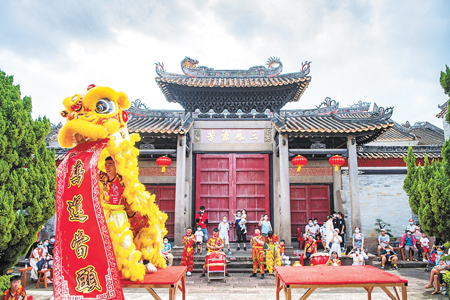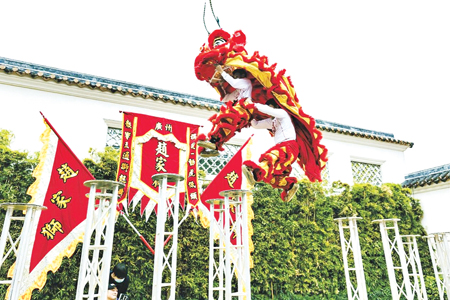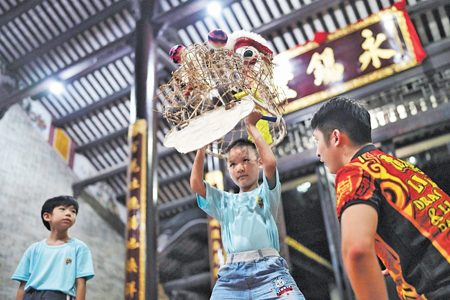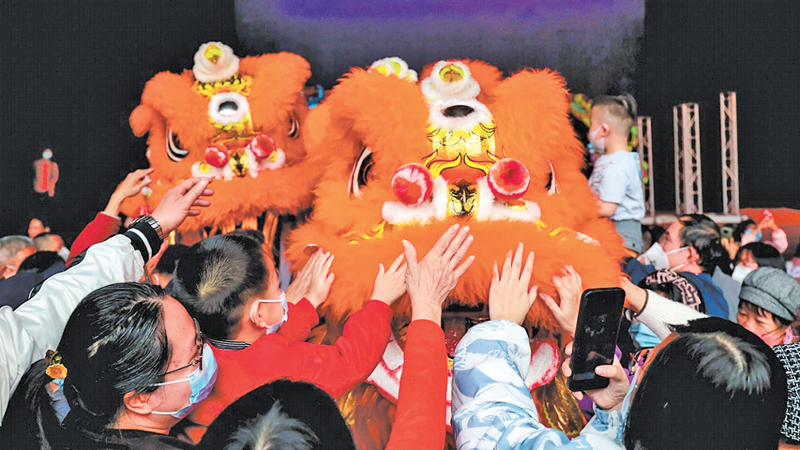“Dum dum boom, dum dum boom…” Every year around the auspicious Chinese New Year, the streets of Guangdong province will reverberate with these thunderous drum beats for Lion Dance (or literally translated as “Awaken the Lion”). The captivating performance never fails to elicit resounding cheers from the local residents.
Lion Dance, steeped in cultural heritage, is a combination of martial arts, dance, and music, which has become an integral part of the Cantonese culture and communities home and abroad. It is no exaggeration to say where there are Chinese people, there will be a Lion Dance.

A Lion Dance performance is staged in the Liugeng Hall of Shawan Ancient Town
Lions were not indigenous in ancient China. So, when did the art of Lion Dance emerge? According to the historical record Book of Later Han, lions were brought to China through the ancient Silk Road.
Lions, the majestic rulers of the animal kingdom, are revered by the ancient Chinese as symbols of courage and power. They believed that lions possessed the ability to ward off evil spirits and bring blessings of safety and happiness. Gradually, Lion Dance evolved into an indispensable part of major celebrations, ceremonies, and festivals. It became a way for people to pray for a life filled with good fortune, luck in all endeavours, prosperous financial success, and continuous upward growth.
The earliest documented record of Lion Dance can be traced back to the Book of Han, where a performance known as “mask-wearing men” is mentioned. Performers wore masks and imitated the movements of a lion to entertain the audience during celebrations and banquets. Such accounts provide one perspective on the origins of Lion Dance.
During the Tang Dynasty (618-907 A.D.), Lion Dance thrived in the imperial court, reaching its peak of development. Under the reign of Emperor Xuanzong, a grand form of lion performance known as “Taiping Yue” (or literally translated as “Peaceful Music”) or “Five-Direction Lion Dance” came into fashion and flourished a splendid performance that showcased the skill and strength of warrior-like dancers.
Intricate movements
The renowned poet Bai Juyi from Tang Dynasty masterfully captured Lion Dance in his poem “Xi Liang Ji” (or literally translated as “Skills of the Western Region of Liang”). With meticulous detail and vivid imagery, he portrayed the intricate movements of the performers, bringing their art to life on the page.

The “Zhao Family Lion” has been passed down from generation to generation in Guangzhou. After Guangdong Lion Dance made the first batch of intangible cultural heritage projects in China, Zhao Weibin, its fifth generation inheritor also became a provincial-level representative inheritor. He is dedicated to the inheritance of the Lion Dance culture
After the Five Dynasties and Ten Kingdoms period (907-979 A.D.), as people from the Central Plains migrated Southward, the tradition of Lion Dance spread from the Central Plains to the Lingnan region.
During the Ming Dynasty (1368-1644 A.D.), Lion Dance already reached the Southernmost part of Guangdong, specifically Qiongzhou (present-day Hainan Province). The Zhengde Qiongtai Zhi (or literally translated as Record of Qiongtai during the Zhengde Reign), a Ming Dynasty historical record, mentioned various plays such as “Lion and Crane”, which can be considered as an early account of Lion Dance in Guangdong.
During the Qing Dynasty(1644-1911AD), various martial arts groups emerged in Guangdong and they established lion associations. The Lion Dance was seen as a way to practise and promote martial arts, which led to their further fusion. In the Cantonese region, almost every township had its own Lion Dance troupe. Wherever there was an ancestral temple, there would be young performers practising the art of Lion Dance.
The Lion Dance in China is generally categorised into two main styles: Southern Lions and Northern Lions, with the Yangtze River roughly serving as the boundary.
Representative of the Southern Lions is the Guangdong Lion Dance, known as “Xing Shi” or “Awaken the Lion”.
The Northern Lions often appear in a pair that consists of a male and a female. Their decorative balls on the heads follow the colour scheme of “red for male and green for female”. In contrast, the Southern Lions, represented by the “Awaken the Lion”, are always powerful male lions. Legend has it that the lion’s image is inspired by the mythical creature called “Suanni”, one of the nine sons of the dragon. Suanni resembles a lion with sharp horns slightly curved forward on its head that are believed to be its special weapon for striking down evil spirits. That’s why Guangdong Lions have a symbolic meaning of warding off evil spirits and promoting good fortune.
Three characters

Young Lion Dancers working hard on their skills
Unlike the Northern Lions, which are mainly orange, traditional Guangdong Lions are primarily yellow, red, and black, representing the three characters of Liu Bei, Guan Yu, and Zhang Fei from the Three Kingdoms. In recent years, even more colours have been put into use in Guangdong Lions to enhance the visual appeal of the performances.
The Northern Lion Dance focuses primarily on physical form by imitating the movements of a lion, including leaping and tumbling. The performance often incorporates acrobatic elements with such highlights as walking on a ball or performing on see-saws. In contrast, the Southern Lion Dance focuses on conveying “meaning”, with dancers portraying the majestic lion through human-like expressions and actions. Various emotions and states, such as joy, anger, sorrow, happiness, action, stillness, surprise, and doubt are used to depict a storyline. Encompassing Kung Fu, dance, and music, Guangdong Lion Dance is an organic fusion of entertainment, artistry, and athleticism. In 2006, it made the first batch of national-level intangible cultural heritage list in China.
The traditional sequence of a complete Guangdong Lion Dance routine is “Sleeping Lion”, “Awakening”, “Emerging from the Cave”, “Mountain Patrol”, “Searching for Greens”, “Gathering Greens”, “Spitting out Greens”, “Licking and Cleansing”, and “Returning”. A performance can feature one or all of these stages based on the time available.
During performances, the lion dancing typically begins with an opening ceremony called “Kai Zhuang” (or literally translated as “Opening the Stake”). This involves the beating of drums and gongs, followed by the lion dancers performing a set of Southern-style boxing as an opening and prelude to the performance.
The boxing ritual, known as “Quan Li” (or literally translated as “Boxing Salute”) holds great significance in traditional Lion Dance. It showcases the dancers’ etiquette before their appearance and also promotes their school of martial arts.
Southern-style boxing stances
Performers primarily rely on Southern-style boxing stances, particularly the horse stance, which is a fundamental skill for lion dancing. Through long-term practice of maintaining a stable horse stance, performers can develop the strong legs required to execute the various challenging movements. It typically takes around two to three years for beginners to handle the lion head. It takes even more time, often at least five years, for athletes who practise with high stakes to achieve seamless coordination between the movements of the head and tail.
The Lion Dance incorporates various symbolic movements such as “opening the eyes”, “washing the whiskers”, “licking the body”, and “shaking the fur”. The main routines include “gathering the greens”, “drinking from a high platform”, “lion spitting out the ball”, and “stepping on the plum blossom-shaped stakes”.
“Gathering the Greens” is the essence of the dance, as it adds dramatic and storytelling elements to the performance. In different stories, the lion collects different types of greens, like wine in the “Drunk Lion” or lingzhi mushrooms in “The Lion Encounters and Collects Lingzhi”.
According to Zhao Weibin, a representative inheritor of the Guangdong Lion Dance, the “greens” used in the “Gathering the Greens” routine typically refer to lettuce, which has a similar pronunciation to “generating wealth”.
Alongside lettuce is often celery (similar in pronunciation to diligence), and garlic (similar in pronunciation to meticulous budgeting). Red packets are sometimes used as well (“lucky money”, also the dancers’ pay). After the lion collects the “greens”, the lion dancers will take the red packets and return the “greens” to the patrons. When they receive the “greens”, it signifies that they have received good fortune and wealth.
According to where the green item is placed, the performance of “Gathering the Greens” can generally be divided into “high green” and “ground green”. In “high green”, the green item is suspended at a height of two to three metres, usually on a ceiling or a long pole. Performers “pluck” the green item using various techniques, such as standing, climbing poles, climbing ladders, ascending platforms, stacking human pyramids, and performing on tall stakes.
Teamwork and coordination
Among them, the lion dancing on tall stakes is extremely challenging. An international standard of 21 plum blossom-shaped stakes is arranged, with the highest one at 2.5 metres, the lowest 1.2 metres, and more than half exceeding 2 metres. It is a daunting manoeuvre as even just one small misstep can cause the performers to fall, so teamwork and coordination are everything. “Ground green” refers to performances that mostly take place on the ground, with the green item placed on the ground or on a platform. “Water green” falls under the category of “ground green” and involves placing red packets in bowls or floating them in water tanks. The performers dance along the edge of the tank, while simultaneously “plucking” the red packets. This form of performance is a true test of the lion dancers’ skills and requires great agility.
Regardless of what the green item is, “Gathering the Greens” is a vivid portrayal of an animated lion with a vibrant spirit—lively, majestic, powerful, courageous, curious, playful, and voracious.
Lion dancing relies on the accompaniment of three percussion instruments: drums, gongs, and cymbals. Among them, the drum takes the lead, as it is always the drums that set the rhythm, then followed by the gongs and cymbals. When played in harmony, their combination creates a resounding cacophony, akin to the roar of thunder. This powerful ensemble enhances the majestic presence of the lion while creating the beats for lion dancers to rhythmically embody the movements of the lion with the utmost realism.
“The performance is fantastic. Guangdong Lion Dance is truly a Kung Fu show. I never get tired of watching it.” “One minute on stage, ten years off stage.” “Chinese Lion Dance embodies Chinese culture, and I feel very excited every time I watch it.” The spectators can’t stop praising the show.
As a cultural symbol of joy and auspiciousness in the lives of Cantonese people, the Guangdong Lion Dance has survived and thrived for a long time. It was performed on the occasion of many large-scale sports events, including the 2008 Beijing Olympics and the 2010 Guangzhou Asian Games.
According to a 2022 survey by the Guangzhou Dragon and Lion Association, over 10,000 people (excluding students) engaged in Lion Dance performances in Guangzhou, of whom over 5,000 are professionals and over 8,000 are non-professionals. More than 30,000 students (primary, secondary, and tertiary) participated in various Lion Dance activities.
Cross-genre works
In recent years, Guangzhou has produced several highly acclaimed cross-genre works based on the theme of Lion Dance, bringing the culture into the national spotlight. Such works include the highly popular dance drama “Awakening Lion” and animated film “I Am What I Am”.
“Awakening Lion” showcases the masculine beauty of lion dancing and won the 11th “Lotus Award” for dance drama in 2018, the highest honour of professional dance in China. On the other hand, “I Am What I Am” received the highest rating among all Chinese-language films in 2021 on the film-rating website Douban. Its original musical also made a successful debut in January 2024.
“Wherever there are Chinese people, there will be a Lion Dance.” During the Qing Dynasty, many people from Guangdong province migrated overseas, taking Lion Dance with them as they settled down. Initially, lion dancing was primarily performed within Chinese communities. Over time, the performances have become a crucial part of the local multicultural activities and gained popularity worldwide.
You can bet to see lion dancing whenever a traditional Chinese festival draws near. Its vigorous and glamorous performances have deeply attracted people from all around the world. As the drums and gongs start to beat, the lion dancing roars to life, instantly filling the air with festivities of Chinese flavour.







